Congrats to Mitch Anderson on these 5 new WUCA/UMCA records in the Standard 18-49 division
| Distance Event Kilometers | Time | Avg Sp (Km) | Avg Sp (Miles) | |
| 300 Kilometer outdoor track | 0:7:42:37.67 | 38.91 | 24.18 | |
| 500 Kilometer outdoor track | 0:13:18:5.80 | 37.59 | 23.36 | |
| Distance Event Miles | Time | Avg Sp (Miles) | Avg Sp (Km) | |
| 300 Mile outdoor track | 0:12:42:10.87 | 23.62 | 38.01 | |
| 500 Mile outdoor track | 0:21:32:10.39 | 23.22 | 37.36 | |
| Timed Event | Miles | Kilometers | Avg Sp (Miles) | Avg Sp (Km) |
| 24 Hour outdoor track | 555.723 | 894.349 | 23.16 | 37.26 |
See Mitch’s report below
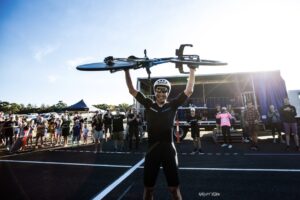
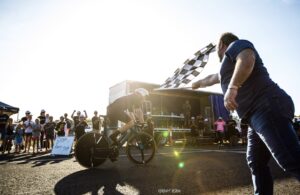
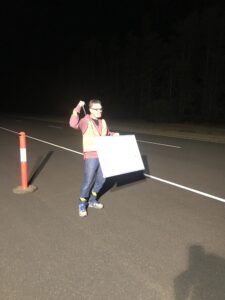
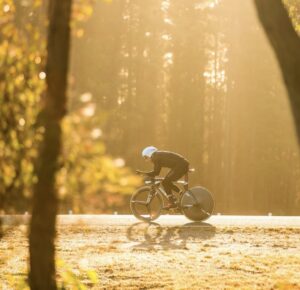
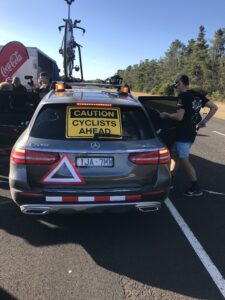
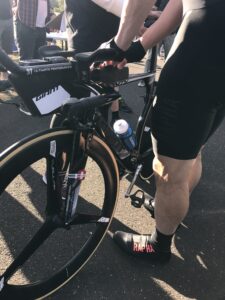
Not Just Another 24hours
895km Outdoor Track Cycling World Record
AARC, Wensleydale Vic April 17:38 30th-31st
By Dr Mitch Anderson
I have a guilty secret: pop-culture is right in my honey hole. But it’s pop-culture of the eighties and nineties that really gets me going- mostly vinyl and movies. So I guess more accurately ‘antiquated kitsch culture’ is my sweet spot. Music: INXS; Australian Crawl; Icehouse; Radiohead; AC/DC. Movies: Groundhog Day; Back to the Future; Ferris Bueller’s Day Off; Miller’s Crossing; Austin Powers: The Spy Who Shagged Me. Speaking of Austin Powers 2 (behave!)- it is rare for a sequel to out perform the original like the Powers sequel. But I feel like my twenty-four hour world record trumped the twelve-hour.
Reinvention post Ironman
Starting on a ‘new’ sport in my forties has been incredibly satisfying. I guess you could argue that I’ve really just re-tooled to a single discipline down from mediocrity at three, but I had to learn a whole new set of training and racing rules to succeed. And it has been (by necessity) a short visit to this fascinating and exhausting pursuit.
The genesis of my interest in endurance cycling was two fold. Firstly, a friend of mine (Andrew Connolly) has been badgering me for years to try something new in sport after thirty Ironman finishes. He had quenched his thirst for ultra distance in six tries only (with a PB of 9:31 executed in Kona!). I managed to squeak into fourteenth overall (just behind Luke Bell) with the fourth fastest bike split (ahead of Peter Reid), but if you think he will let me forget that he out swam me by fifteen seconds…you are sorely mistaken! He was right about Radiohead all along too.
Ginn Agility and 24 Hours
The second catalyst was watching Drew Ginn’s versatility over the years. After achieving gold three times over four Olympic appearances (not mentioning a silver in London in 2012, plus five world championship medals), Drew slipped in an Ironman at Port Macquarie in 2005 (10:05- an elite result cruelled only by ITB friction syndrome stifling his marathon) and turned to cycling (time trialing), finishing 6th at Nationals in 2010 (under two minutes behind winner Cameron Meyer, but significantly ten seconds ahead of stalwart and tt-specialist Peter Milostic).
Ginn tackled a 24 hour outdoor track attempt at Brunswick Velodrome in November 2015. I watched with some awe and interest: apart from a massive endurance motor Ginn’s best features include both audacity and a nihilistic view on failure. Some of his imperfect choices (track length, lighting, practice on a banked track) limited his capacity to exert his will over the world record, but he recorded 836.6km (an Australian record) and raised more than forty-thousand dollars for Tour de Cure (beating cancer a cause close to his heart, losing his mother to the disease in 2003). Imperfection is a hallmark of outdoor records, making adaption and agility pre-requisites.
In short, I benefited greatly from Drew’s Australian record- not only did his attempt capture my imagination but it spawned many animated discussions on how I could achieve such a monument. It’s another intellectual sport (like Ironman), where your work needs to be measured with chess-like precision- nutritionally, logistically and mentally. I work-shopped his attempt with my brains trust (Dr Damien Angus, Dr Andrew Carey, Dr Andre La Gerche, Dr Adam Deacon, Dr Paul Rice, Dr Jonothan Bare, Dr Geoff Thompson, Dr Sam Hume, Dr Brett Anderson, Dr Douglas Johnson and………… Craig Percival…ok, so I consulted almost all the doctors I knew and one endurance sports doyen) and mapped an attempt on the twenty-four WR with a step-wise approach.
9h-12h-24h
Experience over a nine hour practice on the Port Phillip Criterium circuit on May 28th 2016 set me on the right track: for collisions with the council, St Kilda Cycling club and most vitally the heroics of an ultra-cycling legend, Slovenian Marko Baloh. I was certain after this frigid experience (where I averaged ~40km/h over 350km) that I could achieve the 12 Hr track World Record (track is defined by the World Ultra Cycling Association [WUCA] as any circuit less than 5miles) owned by Baloh (460km), which he had achieved during a successful 24 Hr WR attempt of 890km.
And so a 2016 summer of planning for nine hours, made room for ten months of prepping for a 12 Hr Labour Day (March 2017) assault on 500km. A modified circuit saw a perfect day (other than the hubris from Lee Turner/St Kilda Cycling Club) for the attempt. I recorded ~492km (with an actual ride total of 501.6km) proving my mettle for endurance cycling and despite comments otherwise post ride from me (!), a renewed appetite for trying day plus night. I had once again learnt a great deal to prepare and execute over this distance. It had taken me to a dark place, suffering mental and physical anguish over the last three hours. I wasn’t sure if I could or wanted to finish, but I did find a path. Highlighting Craig Percival in my mind helped find that light in the tunnel. With some recovery under the belt (both physical and mental), I set about finding a circuit and head-space to better suit the next challenge.
The Six P’s (Proper Preparation Prevents Piss Poor Performance)
Working on the logistics to prevent any dalliances with constabulary meant going off road into a private facility. I scoured motor racing circuits, trying to match the meteorological requirements with the logistical. Eventually a brain-storming session led to the Linfox owned AARC (Australian Automotive Research Centre) becoming front and centre. That then needed to be married up with a seventy-two hour window of good weather plus track access that fit around my training, work and life schedule. Berrick Wilson and Mick Calder helped grease a viewing, then a track session and commitment from the AARC to donate their bush hidden 3.24km circuit. In the plus column: it was double highway format with smooth-ish road surface and ten percent banked corners. Unfortunately each lap had twelve metres of rise up the back straight with a prevailing head wind (southish). It doesn’t sound much, but I accumulated 3400m of climbing (and concomitant descending) over 275 laps. After 895km of cycling, I can confirm that each lap the rise pinched a little!
I set about getting the three Trinities and Pro discs and tri-spokes I needed, with some SRM to record the best data possible. I wanted two bikes set up the same, with a spare on the car roof in a more relaxed position in case of comfort disaster. It was not required, though I did change bikes a couple of times due to SRM malfunction (I required a re-start due to this problem) and comfort. Mitch Allen (extraordinary mechanic from giant Hampton) worked tirelessly all day and night (and lead up) as did David Ross for both Laurence Basell and for me. Laurence agreed early (and with gusto) to have a dip at the six-hour WR as a curtain raiser for my attempt. He helped me in training (along with the whole group) and eased my anxiety on Good Friday with a show to watch as I prepared!
Science and Guinea Piggery
Partnering with cardiologist Dr Andre La Gerche and Scientist Dr Andrew Carey at the Baker Institute gave me confidence on a number of fronts. Firstly, I could reassure my loved ones that I was being as safe (relatively), both in training, and in execution on Good Friday, having medical guidance throughout. The ride cost 201, 000 heart beats…and that’s not counting those spent in training 270 hours in the three months from January 1st. Ok so I counted 2.3 million beats in training too.
We have collected data from Laurence’s six hour WR (250km), and my twelve (492km) and twenty four hour (895km) WR’s. These heart scans, maximal exercise testing, steady state testing will hopefully lead to a publication but more importantly a deeper understanding of how well trained hearts behave under great stress. The death of 23 y/o elite cyclist Michael Goolaerts from a heart attack at this years’ edition of Paris-Roubaix brings the importance of this into sharp focus. The human body is eminently deformable- but has limits. Let’s hope the data we collected helps define the limits. We also tested my neuropsychological capabilities each hour (numeracy and creative testing) along with perceived exertion (Borg scale).
Abstraction, Denial and Learning
There is not a single time in your life that you perform the same conscious physical skill for twenty-four hours. Sure you breathe, but that’s autonomic. So unless you choose to try something silly like this cycling world mark- it’s an unnatural state of being on many levels. Aside from the brain, metabolically it’s chaos. I burnt over 21 000 calories in twenty-four hours, and if that means nothing to you, it’s 82 Big Macs! Ditto the stress on your muscle, bones, back, gut, kidneys, liver, skin and undercarriage. Ouch, undercarriage. If I had known the damage I would perpetrate in the form of a pressure ulcer on my perineum…I may not have gone down this rabbit hole. I suggested a sealed section with images to the magazines editor Aimee, but she decided they were a bit on the racy side!
Denial is an important part executing this event. I used denial consciously in the lead up, short and long term. To acknowledge to myself what I was going to go through was better left to the reality of the day, rather than imagining the worst in my quiet mind. Even for long training days- thinking about riding 350-400km at 250+ Watts is a sleep-cribbing proposition.
I discussed lots of my preparation and mental state with a psychiatrist who specialises in PTSD (post traumatic stress disorder). He had helped me get through depression and played an integral role in guiding me through to fruition of two cycling world records. He’s added tricks to my sports medical practice that I would never have considered without his tutelage. In my mind, this feat was likely undertaken by someone other than me inhabiting my body. Akin to an alien abducting my legs and lungs while my mind spent twenty-four hours on the planet Endor (funny- no ewoks). It’s hard to describe the feeling of an ultra-event, certainly a degree of internal dissociation is critical to success. The latter hours are almost a transcendent, zen-like state. I sometimes felt this way on the bike in Ironman, but rarely on the run.
The Ride
There’s no tweet or summary that can describe the ride. It’s a sublime experience to enjoy a synchrony between mind, body and my twenty-five years of an acquired exercise skill set. The weather was too cold overnight (8 degrees celcius), much colder than the twelve predicted. This made the air thick and I spent energy on staying warm rather than exercising. As a side effect I suffered from vomiting for at least twelve hours. The last three hours of riding was windy, brutal and blurry…but as I have explained, someone was doing that ride in my body. Essentially, riding 4:48 Ironman bike splits five times over is as close to death you can come without actually dropping off the perch.
Champion Teams and resolutions
I could not have achieved champion results without a champion team. From the very beginning, Aithne (my wife) gave her blessing to tackling something she couldn’t quite understand…but knew made sense to me (in a mad way). Jason Stewart (a patient and now friend of mine) understood and invested countless hours to make the site compatible with infrastructure. I could not have achieved the start line, let alone the finish line without these two on my team. Darren Rutherford and Marty Clucas from Giant, as well as Matt from Shimano made the most elite equipment available to me without question. Rhinomed gave me a way to breathe while eating and drinking during training and racing by providing boxes of product and folding cash-money.
I simply can’t list the names of people who helped make this record a reality, but I have done so on social media. Thanks to my other sponsors: Korupt Vision; Airhub; Rapha; Linfox; AARC; SRM; Ceramic Speed; Trivelo; VTWO; Melbourne Orthopedic Group; Coke Australia and Shinbone Medical. Thanks to my family and friends for all their hard work.
At the open of this article I mentioned that starting a new sport in my forties has been fulfilling- it was. But closing the book on endurance cycling after riding two world records over twelve months (more like 30 months) is equally satisfying. I’m exiting elite competition because quite simply, life (and sport) is too short to focus so much on one gig. I want to keep swimming, rowing, chin-upping, cycling, paddling and mountain biking a bit. But there’s so many ways to float a boat: try family, work, further education, research, small business, photography, reading, vinyl (music) and movies just to name a few of mine! Being too tired to read more than three pages of a novel for two decades of bed times is enough! I need better balance.
I remember being taught in year seven or eight P.E. that fitness was defined in many ways. Not only is it the condition of being physically fit and healthy, but also biologically as an organism’s ability to survive and reproduce in a particular environment. It’s also widely known as the quality of being suitable to fulfill a particular role or task. Having devoted tens of thousands of hours to training to survive in the elite sporting environment, I’m going to devote myself to fulfilling other roles as priorities: fatherhood, husband, medical doctor and mentor. Sure there will still be time for physical fitness, but I’m going to be shooting for fitness in the broadest application.
See you on the road. Or the book shop. Or the record store.
